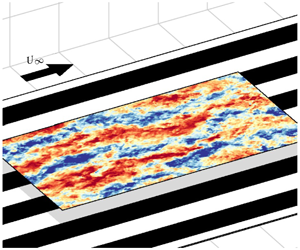Article contents
The effect of spanwise wavelength of surface heterogeneity on turbulent secondary flows
Published online by Cambridge University Press: 29 April 2020
Abstract

We examine the behaviour of turbulent boundary layers over surfaces composed of spanwise-alternating smooth and rough strips, where the width of the strips  $S$ varies such that
$S$ varies such that  $0.32\leqslant S/\overline{\unicode[STIX]{x1D6FF}}\leqslant 6.81$, where
$0.32\leqslant S/\overline{\unicode[STIX]{x1D6FF}}\leqslant 6.81$, where  $\overline{\unicode[STIX]{x1D6FF}}$ is the boundary-layer thickness averaged over one spanwise wavelength of the heterogeneity. The experiments are configured to examine the influences of spanwise variation in wall shear stress over a large
$\overline{\unicode[STIX]{x1D6FF}}$ is the boundary-layer thickness averaged over one spanwise wavelength of the heterogeneity. The experiments are configured to examine the influences of spanwise variation in wall shear stress over a large  $S/\overline{\unicode[STIX]{x1D6FF}}$ range. Hot-wire anemometry and particle image velocimetry (PIV) reveal that the half-wavelength
$S/\overline{\unicode[STIX]{x1D6FF}}$ range. Hot-wire anemometry and particle image velocimetry (PIV) reveal that the half-wavelength  $S/\overline{\unicode[STIX]{x1D6FF}}$ governs the diameter and strength of the resulting mean secondary flows and hence the observed isovels of the mean streamwise velocity. Three possible cases are observed: limiting cases (either
$S/\overline{\unicode[STIX]{x1D6FF}}$ governs the diameter and strength of the resulting mean secondary flows and hence the observed isovels of the mean streamwise velocity. Three possible cases are observed: limiting cases (either  $S/\overline{\unicode[STIX]{x1D6FF}}\ll 1$ or
$S/\overline{\unicode[STIX]{x1D6FF}}\ll 1$ or  $S/\overline{\unicode[STIX]{x1D6FF}}\gg 1$), where the secondary flows are confined near the wall or near the roughness change, and intermediate cases (
$S/\overline{\unicode[STIX]{x1D6FF}}\gg 1$), where the secondary flows are confined near the wall or near the roughness change, and intermediate cases ( $S/\overline{\unicode[STIX]{x1D6FF}}\approx 1$), where the secondary flows are space filling and at their strongest. These secondary flows, however, exhibit a time-dependent behaviour which might be masked by time averaging. Further analysis of the energy spectrogram and fluctuating flow fields obtained from PIV show that the secondary flows meander in a similar manner to that of large-scale structures occurring naturally in turbulence over smooth walls. The meandering of the secondary flows is a function of
$S/\overline{\unicode[STIX]{x1D6FF}}\approx 1$), where the secondary flows are space filling and at their strongest. These secondary flows, however, exhibit a time-dependent behaviour which might be masked by time averaging. Further analysis of the energy spectrogram and fluctuating flow fields obtained from PIV show that the secondary flows meander in a similar manner to that of large-scale structures occurring naturally in turbulence over smooth walls. The meandering of the secondary flows is a function of  $S/\overline{\unicode[STIX]{x1D6FF}}$ and is most prominent when
$S/\overline{\unicode[STIX]{x1D6FF}}$ and is most prominent when  $S/\overline{\unicode[STIX]{x1D6FF}}\approx 1$.
$S/\overline{\unicode[STIX]{x1D6FF}}\approx 1$.
JFM classification
- Type
- JFM Papers
- Information
- Copyright
- © The Author(s), 2020. Published by Cambridge University Press
References
- 65
- Cited by


